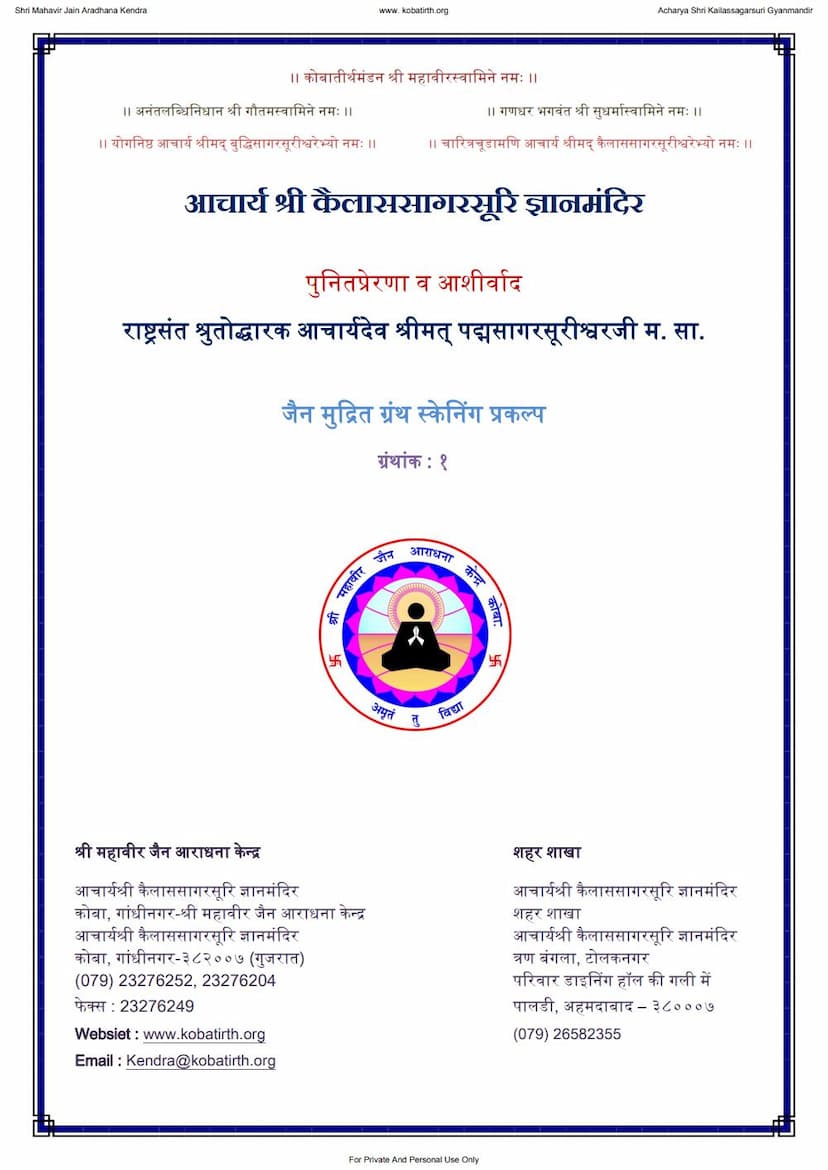Agam 01 Ang 01 Acharanga Sutra Shwetambar
Added to library: September 1, 2025

Summary
Here's a comprehensive summary of the provided Jain text, the Acharanga Sutra, based on the scanned pages:
Book Title: Agam 01 Ang 01 Acharanga Sutra Shwetambar Author(s): Purnachandrasagar Publisher: Jainanand Pustakalay Catalog Link: https://jainqq.org/explore/021001/1
This document is a scanned reproduction of the Acharanga Sutra, one of the fundamental scriptures of the Shvetambara Jain tradition. The reproduction has been undertaken by the Shri Mahavir Jain Aradhana Kendra, Acharya Shri Kailassagarsuri Gyanmandir, for private and personal use. The scanned document appears to be a Gujarati translation and edition, as indicated by the language used in the introductory and explanatory sections.
Key Aspects and Content of the Document:
- Dedication and Homage: The initial pages are dedicated to revered Jain figures, including Lord Mahavir, Ganadhar Sudharmaswami, Gautamswami, and various Acharyas and Munis, expressing deep respect and devotion.
- Inspirational Introduction: The text emphasizes the immense importance and profoundness of "Shrut Gyan" (scriptural knowledge), describing it as a guiding light leading beings out of the darkness of ignorance and delusion. It highlights that the Agamas, the words of Lord Mahavir, are the ultimate foundation of the Jain faith.
- History of Agam Recensions (Vachanas): A significant portion of the introductory material details the history of the compilation and preservation of the Jain Agamas through various recensions (vachanas) after Lord Mahavir's nirvana. It mentions:
- First Recension (Dvadashanga Shrut Sankalan): Held in Pataliputra (Patna) around 160 years after Mahavir's nirvana, led by Sthulabhadra, to address the disorganization of scriptural study caused by a famine and political upheaval.
- Second Recension (Agam Sanrakshan Vachana): Conducted in Ujjain under Arya Suhasti, aiming to rectify deficiencies in study and recitation.
- Third Recension: Undertaken in Kalinga under the patronage of King Kharavela, involving hundreds of monks, nuns, and lay followers to systematically arrange the Eleven Angas and Ten Purvas, especially after periods of persecution.
- Fourth Recension: Held in Dashpur (Mandsaur) around 592 years after Mahavir's nirvana, led by Arya Rakshit Suri, who organized the Agamas based on the four "Anuyogas" (categories of scriptural exposition) to ensure their longevity.
- Fifth Recension: Conducted in Mathura and Valabhi, aiming to reconcile textual variations and preserve the Agamas.
- Sixth Recension: A crucial recension in Valabhi (Saurashtra) by Acharya Skandila and Acharya Nagargun, where the 84 Agamas were systematically compiled and inscribed on palm leaves, marking a significant step in making the Agamas accessible in written form.
- Decline and Revival of Agamic Knowledge: The text laments the decline of strict adherence to Agamic knowledge due to the influence of the kaliyuga from the 10th century onwards, leading to difficulties in accessing and preserving the scriptures. It highlights the efforts in the late 20th century to revive and re-publish these precious texts.
- The Acharanga Sutra Text: The core of the document is the Gujarati text of the Acharanga Sutra, divided into chapters (Adhyayana) and sections (Uddeshak). The sutras, presented in Gujarati, discuss fundamental principles of Jain conduct, ethics, and philosophy.
- Focus on Ahimsa (Non-violence): A central theme is the paramount importance of ahimsa in its strictest sense. The sutras elaborate on the harm caused by various actions and the use of tools and objects, categorizing them based on their impact on different life forms (earth-bodied, water-bodied, fire-bodied, air-bodied, plant-bodied, and mobile beings).
- Ethical Conduct for Monks (Anagars): The text provides detailed guidelines for monks and nuns regarding their daily activities, including movement (Irĩa), speech (Vada), alms-seeking (Eshana), resting places (Shayana, Sthana), and interactions with the world.
- The Nature of the Soul and Karma: The sutras touch upon the nature of the soul, its transmigration, and the consequences of actions (karma). They advocate for understanding the impermanence of worldly existence and detachment from worldly possessions and attachments.
- Classification of Actions and Intentions: The text meticulously explains the ethical implications of various actions, emphasizing the importance of intention (Bhava) and the careful consideration of every deed to avoid harm to any living being.
- Discipline and Austerity: The sutras prescribe rigorous discipline and austerity for monks, including endurance of hardships, control over senses, and detachment from desires.
- Rejection of Unethical Practices: Throughout the text, there's a strong condemnation of actions that involve violence, deceit, attachment, and violation of Jain principles.
- Detailed Eschana (Rules for Accepting Food and Offerings): A significant portion of the sutra text is dedicated to the intricate rules governing the acceptance of food and other necessities by monks and nuns. It details what is permissible and impermissible, considering the purity of the source, preparation, and intention behind the offering. This includes:
- Rules regarding food items (cooked rice, pulses, vegetables, fruits, etc.).
- Rules concerning water and its use.
- Rules about accepting clothes, vessels, and bedding.
- Prohibitions against accepting food that is mixed with living beings, prepared with harmful intentions, or offered with attachment.
- Detailed instructions on how to accept, inspect, and consume offerings while maintaining purity and adhering to strict asceticism.
- The Role of Acharyas and Munis: The introduction and the text itself highlight the roles of enlightened monks and spiritual leaders in guiding the community and preserving the sanctity of the Agamas. The specific edition is a result of the efforts of various esteemed Acharyas and Munis.
- Emphasis on Right Knowledge, Right Faith, and Right Conduct: Underlying all the instructions is the core Jain philosophy of the Three Jewels (Ratnatraya): Right Knowledge (Samyak Darshan), Right Faith (Samyak Gyan), and Right Conduct (Samyak Charitra), which are essential for liberation.
In essence, this scanned document provides a deep dive into the foundational teachings of Jainism as expounded in the Acharanga Sutra. It serves as a guide for ascetics on how to live a life of strict adherence to non-violence, self-control, and ethical conduct, meticulously detailing the practical aspects of monastic life.